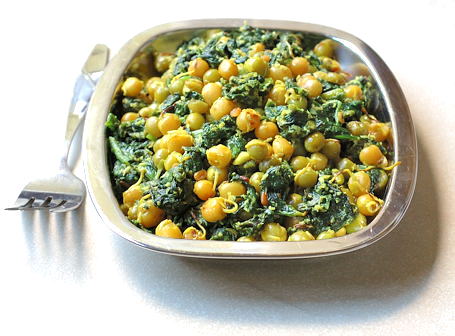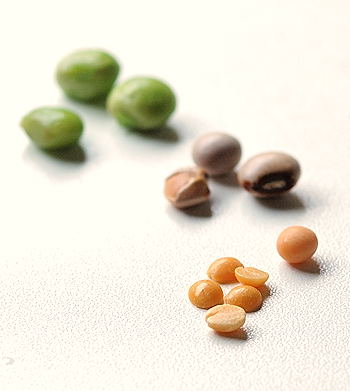
The Most Beautiful and Flavorful Lentil ~ Toor Dal
Fresh, Dried, and Split ~ For This Week’s Indian Kitchen

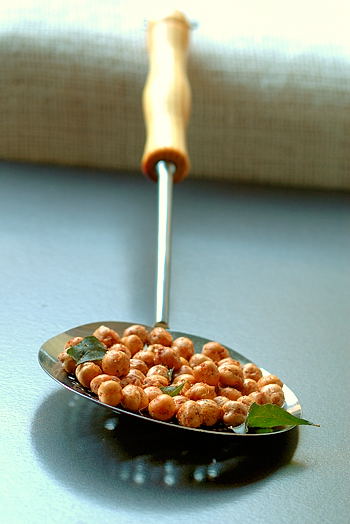
It has been so dreary cold here lately. Soup like dal-rice combo has been my main meal most of the days. Worn-out of my routine tomato dal, I thought of dazzling it a bit. That started a craving for crispy, crunchy chickpeas. A cup of rehydrated chickpeas, 20 minutes in front of hot oil. Now, I remember why I don’t make these often.:) Next time I will simply buy or bake.
For those of you who would like to try the recipe, here we go:
Soak dried chickpeas in water to plump.
Drain and then pat them dry using a kitchen towel.
Deep-fry in batches, in hot peanut oil to crisp.
Prepare spice mixture: Heat a teaspoon of ghee. Add and toast curry leaves, chilli powder, amchur and salt to taste. Toss and coat the chickpeas in spice mixture.
The fried chickpeas are great to jazz up the dal and sambar rice. Also to munch on, and to add to salads.
*****************
What’s This?
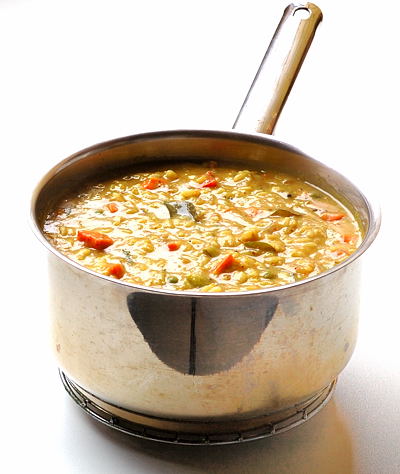
They see each other everyday.
Unassuming and simple, darling daughter of lentil family – the golden Toor Dal.
The upright, some even call almighty – the proud and pristine Rice.
A hill of rice on a banana leaf, and a ladle full of dal next to it. Served and seated next to each other, the attraction between them was instantaneous and electric. It hasn’t escaped the wise hostess notice. The marriage was inevitable. Nourishing vegetables and sensual spices were added for a seductive liveliness. Under the sacred fire, they seized to be toor dal and rice, instead became Bisi Bele Huli Anna. “A match made in heaven, for good times and for hard times”, people praised the joyful union.
Bisi bele huli anna. Yes, all would be all right!
That was the “once upon a time” story for Bisi Bele Huli Anna, the famous south-Indian comfort food. Originated in Karnataka region of India, the rustic and rural Bisi bele huli anna with its uncomplicated, unfettered and fundamental recipe has many fans. From children to very elderly, many Bharatiya find delight in this humble food.
This week’s cold snap made Bisi bele hule anna a prudent choice for us. And, I remembered I had a jarful of Rosematta rice. The plump, terracotta colored rice from Kerala region absorbs flavors very well and I know that toor dal will be swooning in Rosematta company. My preparation started with fresh Bisi bele ground masala and cutting up the vegetables. We can add any number of vegetables and I went with gawar beans, red bell pepper, red onions, peas and carrots. The Bisi bele huli anna turned out to be a delightful meal. Long live Bisi Bele Huli Anna!
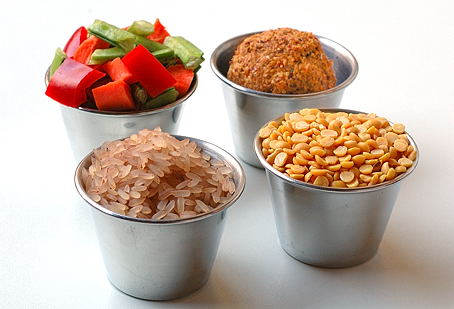
Recipe:
1 cup Rosematta rice
1 cup toor dal (Kandi Pappu)
3 cups cut vegetables (beans, carrots, peas and peppers etc)
2 tablespoons tamarind pulp
1 tablespoon jaggery
½ teaspoon each – turmeric and salt
2 tablespoons – Bisi bele masala (Homemade or store-bought)
Popu or tadka ingredients:
(12 Curry leaves, pinch each- cumin, mustard seeds and hing)
Take rice and toor dal in a wide pot. Add about 6 cups of water. Cook the dal and rice to very tender. Gently mix and mush them. I resorted to pressure-cooking, but back at home, they cook it for an hour or so on slow heat. Results in superb taste.
While the rice and dal are cooking, in another big vessel, heat a tablespoon ghee or oil. Add and toast the tadka ingredients (curry leaves, cumin, mustard seeds and hing).
To the tadka, add the cut vegetables and saute. When they start to get tender, add the tamarind pulp, jaggery, turmeric and salt. Also the cooked and mashed rosematta rice-toor dal mixture. Stir in the masala along with two cups of water. Combine well. Have a taste and adjust the spices to your liking. Cover the pot and simmer for about ten to fifteen minutes on medium-low heat.
Serve hot with a teaspoon of ghee drizzled and with papads.
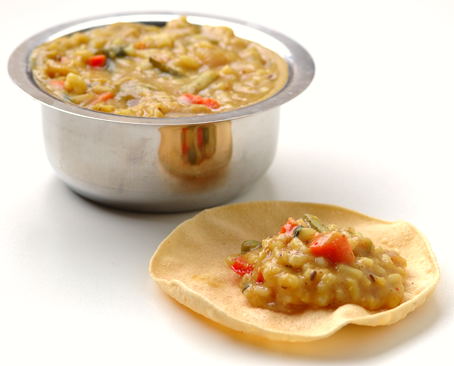
Recipe Notes:
Rosematta idea from My Chow Chow Bhath. Brown rice or brown basmati also works well for this recipe.
My recipe for Bisi bele masala:
5 dried red chillies, 1 tablespoon each- chana dal & coriander seeds, 1 teaspoon cumin, ¼ teaspoon each -cloves, cinnamon, methi seeds and black peppercorn. Dry roast. Cool. Then take them in a Sumeet Mixer or blender. Add 2 tablespoons of freshly grated coconut and pinch of salt. Grind to fine consistency.
Last week I watched a documentary on pumpkins called “Lords of the Gourd,” on PBS. The effort that goes into the giant pumpkin production was really amazing to see. Pumpkins were bathed in milk for prize winning looks, fed on bathtub sized fertilizer solutions, and grown to a groan-inducing size of 800, 1,200, 1,500 pounds – it’s pumpkin passion, godzilla style. The documentary covered many aspects of this competition craziness, but they forgot to mention how these giant pumpkins taste. It doesn’t matter I guess.
If I ever participate in such competition, my pumpkin would be nourished on food blogs feed.:) Thousands of food blogs and all those mouthwatering recipes, the baby pumpkin would have no choice but turn in to a big balloon. Here is the rough sketch of how-to setup. The overfed champion would not only be big, but I am confident that it would also win in taste department. If not, I can always rely on my prized pumpkin recipe “Matar-Kadoo ki Dalâ€Â, the kind of dish that will thrill the taste buds and delight the eyes.
“Matar-Kadoo ki Dal” is a traditional Indian recipe, with green split peas and pumpkin. Typical Indian masala seasoning, and for special spicy touch, wadis (sundried dal-spice rounds) and peppercorn are added. Perfect for cool weather, but watch out for those intracranial explosions.:)

Recipe:
(for two, for two meals)
2 cups green split peas
2 cups pumpkin, peeled and cubed. (I used acorn squash)
½ cup wadis (available at Indan grocery)
1 big red onion, finely chopped, about a cup
1 teaspoon, ginger-garlic-cilantro paste
1 teaspoon goda masala powder (or garam masala)
¼ teaspoon black peppercorns- coarsely crushed
Salt and turmeric to taste
For tadka or popu:
2 tablespoons peanut oil,
Pinch each, cumin and mustard seeds
8-10 curry leaves
Take green split peas in a vessel. Cover with water and simmer to tender (but not too soft).
While the split peas are cooking, in another big pot, heat peanut oil. Add and pan-fry the wadis to crisp. Remove them to a plate and set aside.
In the same pot, to the heated oil, add and toast cumin, mustard seeds and curry leaves. Next goes the onion and ggc paste. Cook until onions are soft. Add the cubed pumpkin, and saute for about five minutes.
Stir in the cooked green split peas along with the water they simmered in. Also, add the goda masala powder, peppercorns, salt and turmeric. If the dal looks too dry, dilute it with water, about a cup. Mix, cover, and simmer for about 10 to 15 minutes, till the pumpkins reach the softness you desire. (Both pumpkin and green split peas cook to soft in short time.)
Sprinkle the crisp wadis and serve with rice or roti. It tasted great on its own also.

From Hindi to English: Matar = Peas, Kadoo = Pumpkin
Recipe adapted from “The Spice Box by Manju Shivraj Singh”
The mere mention of chole, the famous Punjabi recipe with chickpeas, elicits feelings of comfort and good eats. Bring in the Punjabi tinda, the chole becomes extra special.
The food I prepared today inspired by two Punjabi specialties “chole with Punjabi tinda” turned out to be excellent. Along with Punjabi tinda, I also added tomatoes and potatoes to chickpea chole. Few teaspoons of kasuri methi livened up the chole with wonderful aroma.
A harmonious, energizing and filling meal!
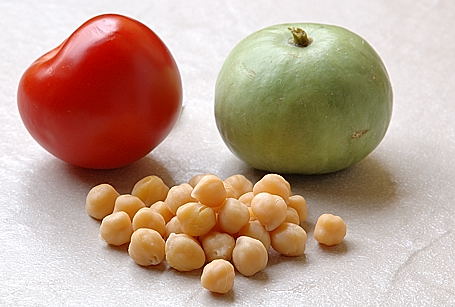
Recipe:
(for two, for two meals)
1 tablespoon – ghee
1 onion- finely chopped
4 tomatoes – finely chopped
1 Punjabi tinda – Peeled and the white flesh cut to cubes
1 potato – peeled and cut to cubes
3 cups chickpeas (cooked to tender)
(Separate ½- cup chickpeas and puree to smooth. Added to thicken the chole)
1 tablespoon – chana masala powder (homemade or store-bought)
Chilli powder, salt, and lemon juice – to taste
1 tablespoon – kasuri methi
Heat ghee in a big pot.
Add onions and tomatoes. Saute to soft mush.
Add Punjabi tinda and potatoes. Saute to tender.
Stir in chickpeas, the chickpea paste, chana masala and chilli powders, and salt.
Add about one cup of water. Combine. Simmer, covered for about 15 to 20 min.
At the end, sprinkle the kasuri methi and lemon juice.
Mix and serve right away. Great with chapati/roti and rice.
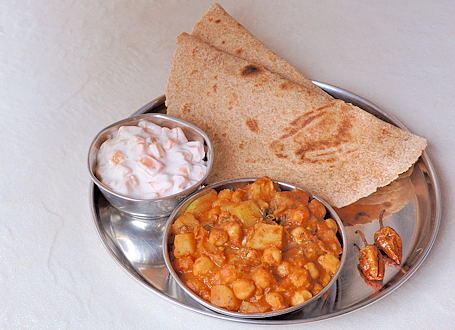
Notes:
Punjabi tinda is a small variety squash native to North India and prized for its pleasant taste.
Features: green skin and white colored flesh, firm texture, mildly sweet taste, size about an apple.
Available at local Indian grocery shops during Oct-Nov(seasonal), and also frozen and in tins.
Kasuri Methi = Sun-dried fenugreek leaves
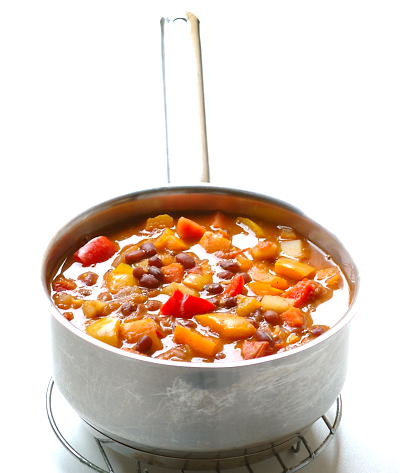
African food, at least here in the west, is usually restricted to East African staples like the delicious Ethiopian dosa, the Injera or entrees such as the equally delectable Moroccan chickpea stew (normally served over couscous) common to North Africa.
But what of the quintessentially South African Chakalaka?
As one examines the recipe, it’s not hard to imagine South African cooks venturing out into their vegetable garden one hot day, picking onions, red peppers, tomatoes and any other readily available seasonal produce. As the vegetables cooked, they probably craved some of the flavors they remember smelling as they walked down a street with Indian houses. Inspired, they might have thrown in a liberal dose of curry powder into the simmering vegetables in the pot. Since many variations also include tinned baked beans, hungry laborers might have adapted it as a quick and satisfying one-pot meal at the end of a hard day of slogging it in the gold mines.
With my well-equipped Indian kitchen, Chakalaka was a breeze to whip up. Indeed, the Indian influences are not surprising. Indians have been in South Africa longer than Caucasians have been in Canada! So at least for 7-8 generations. In fact, our beloved Mahatma Gandhi cut his revolutionary teeth in South Africa.
But back to Chakalaka (don’t you just love the sound of the name?)
While the jury is still out on whether Chakalaka is a chunky ketchup or a sauce or a cooked salsa (could be either); on whether it should be served as a side dish or a condiment (served as both) and if it should be eaten hot or cold (served either way), this spicy and always vegetarian concoction has now come to be identified as the definitive taste of South Africa. There’s even a restaurant in London named for this dish. Featuring a standard base of onions, tomatoes and peppers; this versatile dish is open to endless experimentation.
Other bloggers tell us that traditionally, Chakalaka is often served as a sauce with a maize porridge (Mielie Pap) that is eaten predominantly by the local black population. It’s also served with bread or the ragi-like Samp, made of maize. It can also be spotted as an accompaniment at South African barbecues called Braais (pronounced “bry”, rhyming with the word “cry”)
In the spirit of making a mean Chakalaka that is true to its African roots as well as its spirit of assimilation and innovation, my version is based on a number of recipes found online as well as one that was featured in the Toronto star.
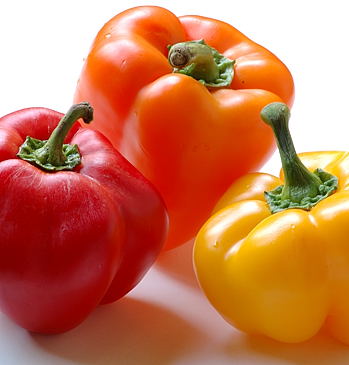
Recipe:
(Makes enough for approx 30 tablespoon servings)
2 tablespoons of sunflower oil
1 inch piece of ginger, peeled and finely diced
2 cloves of garlic, peeled and finely diced
4 fresh green chillies, slit
1 big red onion, finely chopped
A pound (4 to 6) juicy tomatoes, finely chopped
3 bell peppers, chopped into 1cm X 1cm pieces
2 carrots and 2 potatoes chopped into 1cm X 1cm pieces
Curry powder – 1 heaped tablespoon.
Red beans – one cup, pre-soaked and pressure-cooked to tender
Salt – one teaspoon, or to taste
Fresh coriander for garnish
In a saucepan, heat up the oil and saute ginger, garlic, chillies and onions to soft. Add the salt and curry powder. Add the tomatoes and cook till mushy and of sauce consistency. Add peppers, carrots and potatoes. Cook till they are of a desired softness. Add the red beans and cook for 5-10 minutes. Remove from heat and add coriander. Check seasoning levels and serve with rice or breads of your choice.
A small confession. After adding the beans, I tasted it and found the heat was a bit too much. So I caved and added a teaspoon of jaggery at the end. Unsuspecting victims, tasters of the dish said it took them to whole new levels of delayed heat which overwhelmed the palate after the initial deceptive sweetness. But they all agreed they couldn’t get enough of it!
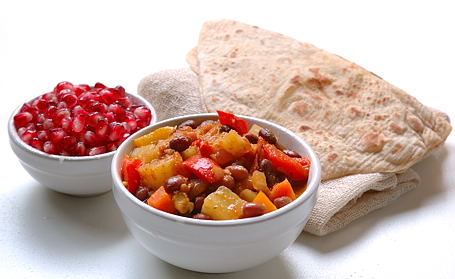
~ Article Contributed by Janani Srinivasan
Photos by Indira Singari.
Kitchen Notes:
Other vegetables can also be added to Chakalaka – cauliflower, zucchini, string beans etc
For curry powder – if you have access to it, I recommend the fiery Sri Lankan Niru brand powder so ubiquitous in Toronto. If not, any other store-bought or homemade will do. The South African recipes recommend a local brand called “leaf masala”.
To be true to the grassroots appeal of this dish, you could use a can of baked beans from the local supermarket. Vegetarians check labels to ensure it’s free of lard or any other animal ingredients. If you can soak your own from scratch, that’s even better.
More on Chakalaka : Chakalaka 101, and Culinary Musings from Cape Town
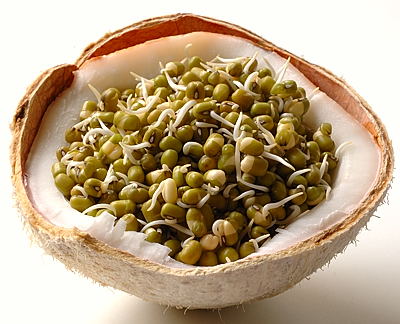
Mooga-Gaathi, a traditional Goan-Konkani recipe with sprouted moong beans and fresh coconut may sound like another unassuming moong dal preparation. But you would be delighted to find out the appetite-arousing attitude of this homey, gentle sounding dish. All thanks to spices – nutmeg, cloves, coriander and peppercorn.
The recipe is from my friend Veena Parrikar‘s kitchen. I made small changes here and there to the original to suit my taste. Easy to prepare, minimum work, no cutting or slicing things, and satisfying results. A perfect autumn recipe and a must try for sprouted moong bean fans. I totally recommend.
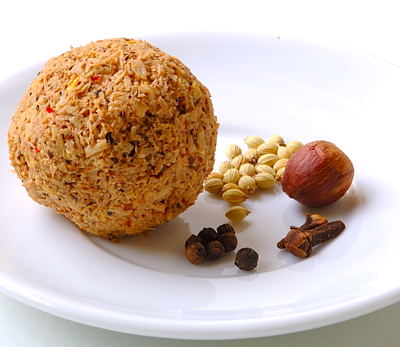
Recipe:
(for two, for two meals)
Sprouted moong(mung) beans – 4 cups
Fresh coconut gratings – 2 tablespoons
Spices:
Nutmeg – a small piece
Cloves – 3
Coriander seeds – 1 teaspoon
Black Peppercorn – ¼ teaspoon
Dried red chillies – 2
Tamarind pulp – 2 teaspoons
Turmeric – ¼ teaspoon
Salt – ½ teaspoon or to taste
For popu or tadka:
1 tablespoon ghee or oil
8 curry leaves
¼ teaspoon each – cumin, mustard seeds and asafoetida
1. Place a wide pot on stove-top and heat.
Add and dry-roast the nutmeg, cloves, coriander seeds, black pepper and dried red chillies to fragrance. Remove them to a mixer. Add fresh coconut and grind to smooth paste. For easy blending, you could also add about half cup water.
2. In the same pot, take sprouted moong beans. Add about 2 to 3 cups of water and stir in salt. Cover and cook. When moong beans reach required level of tenderness, add the ground-spice paste, tamarind and turmeric. (I also added a tablespoon of jaggery.) Mix well and simmer on medium heat.
3. While the moong is simmering, do the popu or tadka. In a small skillet, heat oil until a curry leaf tossed in it sizzles. Add and toast curry leaves to pale gold. Next goes the cumin, mustard seeds and asafoetida. Wait for the mustard seeds to splutter. And, immediately add the skillet contents to simmering moong dal. Mix, reduce heat and simmer for another five to ten minutes to blend the flavors.
Serve or spoon into a small bowl and enjoy with rice or chapatis.
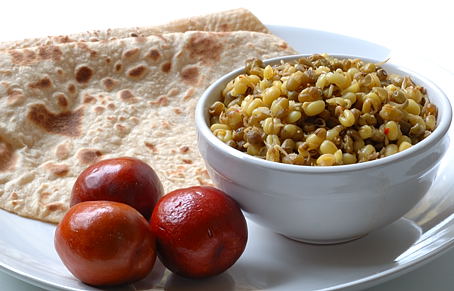
Notes:
The original recipe did not have cumin seeds in tadka/popu. They are not used in gaathi.
How to sprout Moong Beans: Soak moong beans in water overnight. Next morning, drain into a muslin covered colander. Cover the beans with cloth, and keep the colander in a warm area. Sprinke water occasionally to keep the cloth moist. Within a day, you start seeing the sprouts. Wait for next morning. There you go, you have your own homemade sprouts ready for Mooga-Gaathi.
The taro root I planted in May has now grown to a decorative type of plant with beautiful looking leaves. Growing taro at home turned out to be an easy process. I have planted small variety taro similar to what we see around Nandyala region, India (which is different from the elephant or giant type taro). I placed a healthy looking taro root in a container and loosely covered it with soil. Kept the container in patio where the sun shines and watered it daily. In just two months, around July, a young shoot appeared. Now the plant has six healthy looking leaves and thriving.
My taro growing fancy is mainly for taro leaves. The leaves are perfectly edible plus they are nutritious. We use only young leaves for cooking. With unique flavor and great taste, young taro leaves are easily likable. Back at home in Nandyala, my mother prepares two recipes with young taro leaves – a spinach style curry, where the blanched and finely chopped leaves are sautéed with onions and second is a flavorful dal where the taro leaves are steamed with toor dal. Dal has been invariably my favorite taro leaf preparation and is our meal today.
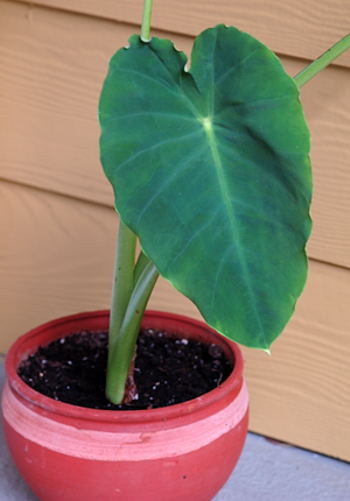
Recipe:
Toor dal – 1 cup
Young taro leaves – 4 (about the size of ping-pong paddle), finely chopped
1 small onion and 6 green chillies – coarsely chopped
Tamarind pod – about the size of a small finger, seeds removed
¼ teaspoon turmeric
Take them all in a pressure cooker. Add about two cups of water and cook until the dal reaches fall-apart stage. Once the valve pressure is released, remove the lid and add half teaspoon of salt to the cooked contents. Mix, and gently mash the dal to soft consistency with wood masher or immersion blender. Set aside.
Now do the tadka: In a small pot, heat a tablespoon of oil or ghee over a medium-hot burner. Add a teaspoon of minced garlic, a sprig of fresh curry leaves. Toast them to pale brown. Then add a pinch each – cumin, mustard seeds and asafoetida. Stir and wait for the mustard seeds to pop. This process is called tadka.
Add the mashed dal to the tadka contents and mix thoroughly. Serve the dal over rice or chapati with a teaspoon of ghee drizzled in for a scrumptious meal.
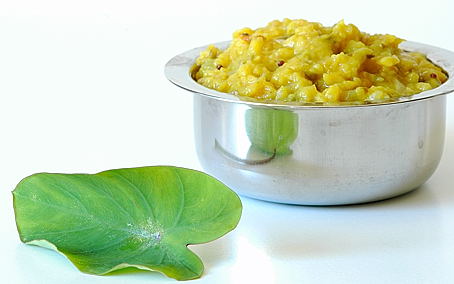
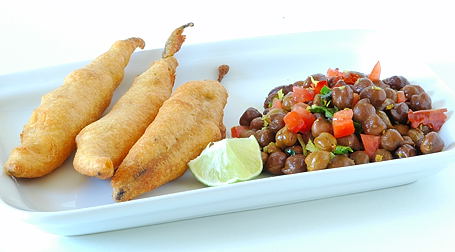
Recipe Source: Amma, Nandyala
I see the world around me. There is a deep tantric style worship of all-purpose flour and its endless avatars. All-purpose flour, butter, eggs and sugar: the central content is the same but by just changing the vessel and the decorations, several different avatars are possible. Like the prayers to the Gods, the all-purpose flour mantram resonates like this: cakes… yum, cookies… yum, cupcakes… yum, muffins… yum, bread… yum, biscotti… yum, pizzas, pies, scones… yum … yum … yum … the mantram goes on. The sugar bliss and the atma content follow… yum!
I am amazed by this boundless fascination all-purpose flour attracts. The Maya intensity of all-purpose flour is so great that each of its avatars is perceived as its own creation. I too use the flour mantram, but the avatars are limited to chapati… yum, puri… yum, paratha… yum. I’m just talking out loud.
Anyway, cakes and cookies could be divinely delicious, but vegetables are what inspire me to cook and write. Vegetables keep me happy in a world which is insanely flour-sugar coated. So here it is, another sane vegetable recipe from an all-purpose flour atheist. A hearty, dense, satisfying dal recipe with ridge gourd and moong dal, called Kootu.
Attempt this kootu recipe only when you have asafetida in your kitchen. Because the tiny amount of asafetida is what makes the recipe come alive. Onions and garlic are a big no but potatoes are a must. Ridge gourd, drumsticks and brinjal separately or together in combination are added to cooked, watery moong dal. And the whole thing gets simmered until a thick, honey like consistency is achieved. This is a good dal recipe for people who have low tolerance levels for onions and garlic, and also during early pregnancy times. Mild and soothing, this moong dal Kootu is a favorite for moong fans like me.
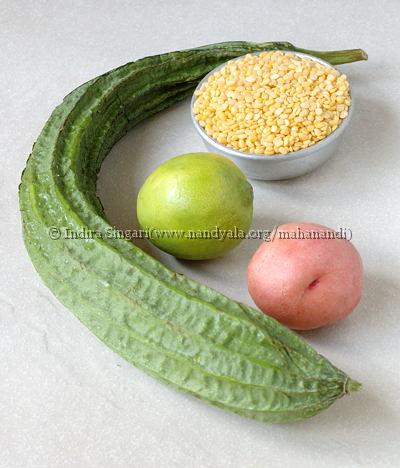
Recipe:
Step 1: 1 cup yellow moong dal – Roast the yellow moong dal to pale red color in an iron skillet. Take the roasted dal in a pressure-cooker, add about 4 cups of water and pressure-cook to soft. Then, lightly mash the dal to smooth consistency.
Meanwhile blend six green chillies, two tablespoons of grated fresh coconut and a pinch of salt to smooth paste.
Step 2: In a saucepan – add a teaspoon of oil. Add and saute two cups of cubed potatoes first. Once the potatoes are half cooked, add 2 cups of finely chopped ridge gourd pieces and saute to tender. (3 potatoes and 1 ridge gourd.)
To the vegetables, add the mashed moong dal, green chilli-coconut paste, ½ tsp each -turmeric and salt, plus a quarter cup of lime/lemon juice, along with two cups of water. Mix, have a taste and adjust the spice, salt to your liking. Simmer for about 10 to 15 minutes.
Step 3: In the end, do the popu or tadka. Add and toast few curry leaves, dried red chilli pieces, cumin and mustard seeds and quarter teaspoon of asafetida in an iron skillet in a small amount of oil or ghee. Add the toasted contents to simmering dal. Mix and serve hot with chapatis. A state of bliss will surely follow.
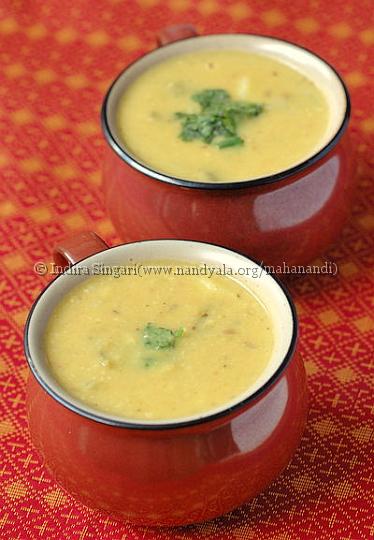
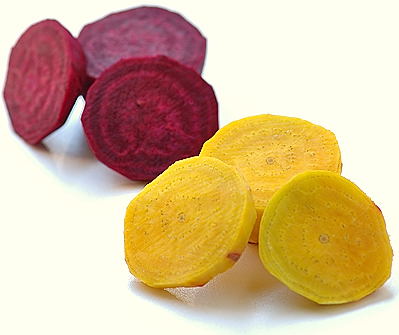
The flavor and the color of beets are unique. Their sweetness is more like saccharine than sugarcane. One thing is for sure, they do brighten up any meal with that bold, ruby-red color. But the new variety, the golden beets that I see at farmers markets in recent years is little bit different. They taste more like carrots than beets and they do not stain or bleed like red beets. I personally feel that golden beets taste much better than red beets. But, they are still in designer, fancy stage and I look forward to the days when they become more affordable.
After the yesterday’s curry, I had three each, red and golden beets left from Sunday’s farmers market purchase. I have added few carrot pieces to the bunch and made a hearty sambar with toor dal. The sweet beets and carrots, creamy rich toor dal and spicy sambar masala, together with rice and papads ~ it was a good supper today.
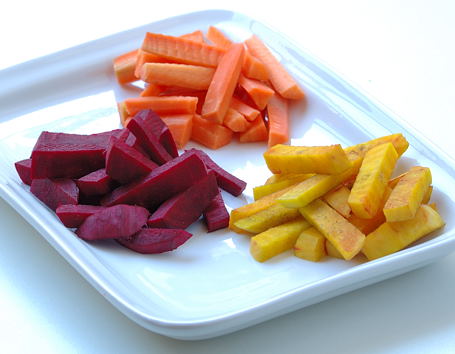
Recipe:
Pressure-cook the dal:
Take one cup toor dal and two cups water in a pressure-cooker. Cook the dal to very soft and mash to smooth with an immersion blender or wood masher.
Prepare the vegetables:
Carrots, red and golden beets, 3 each – peel, cut to thin, two-inch length pieces
tomato and onion – one each, finely sliced
Do the Popu and Simmer:
In a heavy pot, heat a teaspoon of oil until a curry leaf tossed in it sizzles. Keep the heat to medium. Add a sprig of curry leaves and toast to pale gold color. Then, add a pinch each cumin and mustard seeds. When seeds start to pop, add the onions. Saute to soft. Next goes tomatoes, carrots and beets. Saute for about ten minutes.
Then, stir in half teaspoon each – turmeric, salt, red chilli powder and a tablespoon each –sambar masala powder and tamarind pulp. Also the cooked and mashed toor dal along with three cups of water. Mix everything thoroughly and bring to a boil. Reduce the heat, partially cover the pot and simmer until the vegetables are soft. Stir frequently and well, as the toor dal tend to sink to the bottom and stick. Garnish with few sprigs of finely chopped coriander leaves if you wish and serve warm. Tastes great mixed with rice.
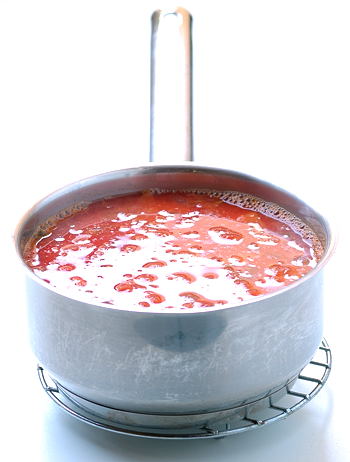
There is nothing like a green leafy vegetable and dal combination. Otherwise difficult to like fibrous green leafy veggies magically render to mellow texture when combined and cooked with Indian dals.
Last Sunday, in addition to fresh amaranth, I also bought chard at local farmers market. 5 chard leaves for a dollar and thirty cents. Chard leaves are almost the size of young banana leaves. That big but they are delicate like spinach. They also taste similar to spinach. Makes a good meal when combined and cooked with masoor dal or toor dal.
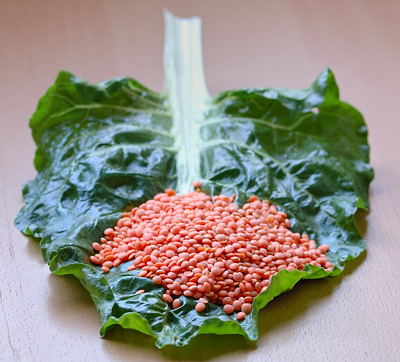
Recipe:
1 cup – masoor dal (red lentils)
5 – fresh chard leaves, coarsely chopped
1 each – onion and tomato, cut to big chunks
8 to 10 – finely chopped Indian variety green chillies
Cherry fruit sized, raw tamarind
½ teaspoon each – turmeric and saltFor popu or tadka:
1 tablespoon ghee or oil
¼ teaspoon each – cumin, mustard seeds, and minced garlic
6-8 curry leaves
Take masoor dal in a pressure-cooker. Rinse with water and drain the water.
Add the chard, onion, tomato, chillies, tamarind and turmeric, along with three cups of water.
Mix and pressure-cook for about 10-15 minutes on high heat and then allow the pressure to come down naturally. Remove the lid, usually the dal will be cooked to tender. Add salt and lightly mash the ingredients. The dal is now ready for the final “Popu or tadka” touch.
In a skillet, heat the ghee until a curry leaf tossed in it sizzles. Keep the heat to medium. Add the curry leaves and garlic. Toast to pale gold color. Then, toss in cumin and mustard seeds. When seeds start to pop, add the whole thing to mashed dal. Mix and serve.
Chard-masoor dal tastes good with rice and chapati.
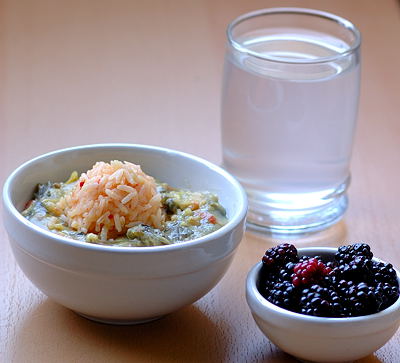
Dazzling Dals ~ From My Digital Cookbook:
1. Amaranth Dal (Thotakura Pappu) ~ from Nandyala
2. Brinjal Dal (Vankaya Pappu) ~ from Nandyala
3. Fenugreek Dal (Menthi kura Pappu) ~ from Nandyala
4. Gongura Pappu (Ambadi Dal) ~ from Nandyala
5. Khatti Dal ~ Hyderabad Style
6. Lemon Cucumber Dal (Budamkaya Pappu) ~ from Nandyala
7. Mango Dal (Maamidi Kaya Pappu) ~ from Nandyala
8. Ridgegourd Dal (Beerakaya Pappu) ~ from Nandyala
9. Spinach Dal (Palakura Pappu) ~ from Nandyala
10. Spinach – Garlic Dal ~ from Kosta Region, Andhra
11. Spinach Mango Dal (Palakura Pullakura) ~ from Telengana
12. Spinach-Split Pea Dal ~ American Influence
13. Sprouted Masoor Dal ~ North India inspired
14. Tomato Dal (Tomato Pappu) ~ from Nandyala
15. Tindora Dal (Dondakaya Pappu) ~ from Nandyala
16. Moongdal Aamti with Kokum and Goda Masala ~ Maratha Influence
17. Mungdal and Ridgegourd (Beerakaya Pesara Pappu) ~ from Andhra
I had an another recipe in mind with black-eyed bean sprouts for today’s meal. But I accidentally over-cooked the beans to mush. Thus born the bean dip for rotis.
The beautiful pale red color of the dip is from chipotle chillies. I really love how the spicy chipotle perk up a recipe with smoky flavor. I have also added fragrant cumin and lively lime juice to the pureed beans. The dip may be a last minute solution to the mushed bean problem, but the result was attractive and had a great taste, similar to refried beans that they serve in Mexican restaurants.
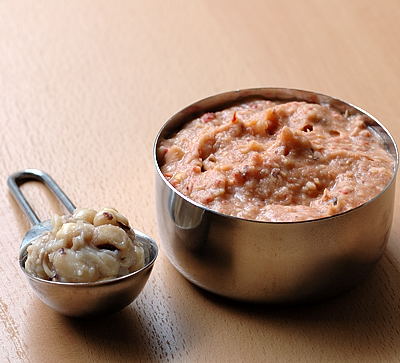
Recipe:
Precooked black-eyed bean sprouts or beans – 1 cup
Dried chipotle chillies – 2 (presoaked in warm water for about 30min)
cumin – half teaspoon
salt – half teaspoon or to taste
Lime juice -2 tablespoons or to taste
Take the chipotle chillies and cumin in a Sumeet style mixer or food processor. Pulse few minutes until the chillies are very smooth. Add the black-eyed bean sprouts, salt and lime juice. Process to fine puree. Remove to a cup and refrigerate for about 30 minutes to let the flavor develop. Serve with roti/tortillas or corn/taro root chips.
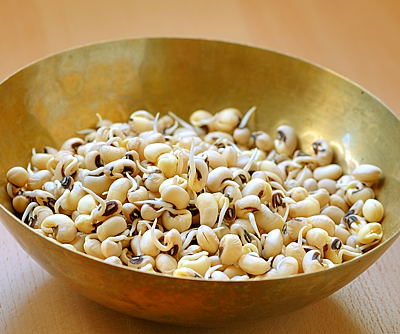
These black-eyed peas are from Indian grocery shop (Apna Bazar, Bellevue), and are imported from India like most of the lentils and legumes. Sprouting was easy with these peas. But when I tried the same last week with some American store-bought black-eyed peas, they didn’t sprout. Same thing happened with Adzuki beans.
Are these American peas and beans genetically modified? Why aren’t they coming to life?
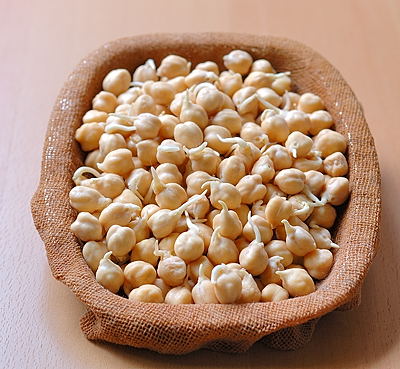
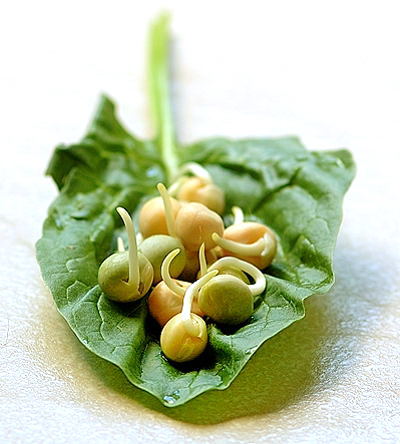
Sreemathi Kamalabai Ogale, my authority on Maharashtrian vegetarian cuisine has written in Ruchira that usal can be prepared with fresh or rehydrated dried peas and also with sprouted ones. So, I reserved a cup of sprouted peas to try the usal recipe today. I couldn’t resist adding little bit of green – the fresh spinach from the local ritu bazaar. Two pretty and ordinary foods together became an extraordinary combination, all thanks to miracle like Marathi usal recipe. What a way to enjoy the sprouted peas!
Recipe:
1 teaspoon peanut oil
¼ tsp each – mustard seeds and asafetida
1 cup – yellow and green sprouted peas
1 bunch – fresh spinach, finely chopped
¼ tsp turmeric
2 tablespoons fresh coconut gratings, 4 green chillies and ¼tsp cumin
(blend to smooth paste)
Salt to taste or ¼ tsp
Heat peanut oil in a wide skillet.
Add and toast mustard seeds and asafetida.
When seeds start to pop, add the sprouted peas and reduce the heat to low.
Sprinkle handful of water, cover and steam-cook the peas to tender.
Add the chopped spinach.
Sprinkle turmeric, coconut-chilli-cumin ground paste.
Mix and cook until the spinach collapses. Season with salt and serve hot.
